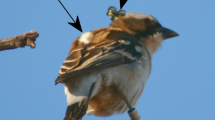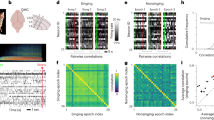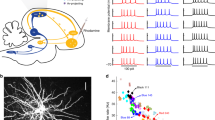Abstract
Bird songs frequently contain trilling sounds that demand extremely fast vocalization control1,2. Here we show that doves control their syrinx, a vocal organ that is unique to birds, by using superfast muscles. These muscles, which are similar to those that operate highly specialist acoustic organs such as the rattle of the rattlesnake, are among the fastest vertebrate muscles known and could be much more widespread than previously thought if they are the principal muscle type used to control bird songs.
Similar content being viewed by others
Main
The syrinx of ring doves (Streptopelia risoria) generates a relatively simple, highly stereotyped song — the familiar cooing sound. The coo contains a trill, whose elements are generated at repetition rates of up to 30 Hz (Fig. 1a). When doves coo, respiratory airflow excites membranes in the syrinx3, causing them to vibrate4,5. The vibrations depend on the tension in the membranes3,6, which is modified by activating two pairs of syringeal muscles5,7. These muscle pairs act as antagonists5: the tracheolateralis muscles cause the membranes to move out of the tracheal lumen (abduct), whereas the sternotrachealis muscles cause the membranes to slacken and to adduct.
a, Sound oscillogram, spectrogram and electromyographic activity of tracheolateralis (TL) muscles (upward, integrated; downward, rectified) during the trill. TL activation (blue boxes) precedes the corresponding trill elements (purple boxes). Asterisk indicates TL burst associated with the first trill pulse (trill 1). b, Normalized traces of in vitro force modulation of TL and sternotrachealis (ST) muscles during a stimulation pattern (green bars) based on an averaged trill (mean (black trace) ± s.d. (pink trace); n = 4).
We made simultaneous in vivo recordings of muscle activity and sound in cooing doves and found that the electromyographic (EMG) activity of the tracheolateralis muscles correlated significantly more strongly with voiced, rather than silent, periods: activating these muscles switches the sound on, and not off as previously thought5, by positioning the membrane in the airflow. We also found that modulation of the tracheolateralis muscles' EMG correlated strongly with changes in sound frequency: the muscles change the tension in the membranes, which changes the frequency of the sound. (For methods, see supplementary information.)
A dove's trill cannot be achieved using typical vertebrate muscles, because they do not switch on and off fast enough to control the trill's brief sound elements (⩽9 ms). The syringeal muscles must also contract aerobically to power cooing sessions that can last for many minutes. These extreme requirements can be met only by aerobic superfast muscles8. This muscle type is the fastest known in vertebrates: its twitch half-time is less than 10 ms, which is one to two orders of magnitude faster than that of typical locomotory muscles8.
Our measurements show that dove syringeal muscles attain superfast kinetics. The twitch half-times of the tracheolateralis and sternotrachealis muscles are 9.2 ± 0.8 ms and 10.3 ± 1.7 ms, respectively, and the stimulus repetition rates necessary to obtain tetanic contraction are 200–275 Hz for tracheolateralis and 200–400 Hz for sternotrachealis muscles. But, like all superfast muscles, the syringeal muscles trade force for speed9: they exert low twitch stresses (tracheolateralis: 8.0 ± 4.8 kilonewtons per m2; sternotrachealis: 20.6 ± 15.7 kN m−2).
We also subjected the syringeal muscles to a playback signal based on the in vivo EMG pattern. During the simulated trill, both types of muscle modulate force (Fig. 1b). As the silent intervals in the playback signal shorten from 12 to 3.5 ms, neither is able to relax completely between trill elements.
Our results indicate that both muscles exert control directly at the syringeal membranes by altering the membrane position, which in turn alters membrane tension. The tracheolateralis muscles pull the syringeal membranes apart, thereby allowing them to vibrate in the airflow, which supports indirect evidence that the syrinx is closed between trills10. This control mode implies that gating is determined by the membrane position and that membrane tension determines pitch.
Our in vitro experiments show that both syringeal muscles have the superfast properties necessary to control individual sound elements during the dove's trill. Co-activation of the antagonistic muscles affords the bird very fast and accurate position control of the syringeal membranes, akin to saccadic eye and rapid arm movements11.
Birds modulate their songs extremely rapidly, with frequencies exceeding 100 Hz (ref. 2). Although the intrinsic nonlinear properties of the syrinx6 add complexity to the level of motor control, only muscle control can explain the fast but gradual modulations that underlie the extraordinary intraspecific variability and flexibility of phonation1. The stereotyped coos of doves are considered to be simple vocalizations among birds, but even doves use superfast muscles to control their song. Given their added vocal complexity12, songbirds have probably evolved muscles that outperform the syringeal muscles of doves. Superfast muscle can no longer be considered a rare adaptation, found for example in the highly derived acoustic organs of the toadfish and rattlesnake8. We suspect that superfast vocal muscles are widespread among birds.
References
Greenewalt, C. H. Bird Song: Acoustics and Physiology (Smithsonian Institute, Washington DC, 1968).
Goller, F. & Suthers, R. A. J. Neurophysiol. 75, 867–876 (1996).
Fletcher, N. H. J. Theor. Biol. 135, 455–481 (1988).
Larsen, O. N. & Goller, F. Proc. R. Soc. Lond. B 266, 1609–1615 (1999).
Goller, F. & Larsen, O. N. J. Exp. Biol. 200, 2165–2176 (1997).
Fee, M. S., Shraiman, B., Pesaran, B. & Mitra, P. P. Nature 395, 67–71 (1998).
Gardner, T., Cecchi, G., Magnasco, M., Laje, R. & Mindlin, G. B. Phys. Rev. Lett. 87, 208101 (2001).
Young, I. S. & Rome, L. C. Proc. R. Soc. Lond. B 268, 1965–1070 (2001).
Rome, L. C., Syme, D. A., Hollingworth, S., Lindstedt, S. L. & Baylor, S. M. Proc. Natl Acad. Sci. USA 96, 5826–5831 (1999).
Beckers, G. B. L., Suthers, R. A. & ten Cate, C. J. Exp. Biol. 206, 1833–1843 (2003).
Harris, C. M. & Wolpert, D. M. Nature 384, 780–784 (1998).
Goller, F. Nature 395, 11–12 (1998).
Author information
Authors and Affiliations
Corresponding author
Ethics declarations
Competing interests
The authors declare no competing financial interests.
Rights and permissions
About this article
Cite this article
Elemans, C., Spierts, I., Müller, U. et al. Superfast muscles control dove's trill. Nature 431, 146 (2004). https://doi.org/10.1038/431146a
Published:
Issue Date:
DOI: https://doi.org/10.1038/431146a
This article is cited by
-
Daily vocal exercise is necessary for peak performance singing in a songbird
Nature Communications (2023)
-
Adaptations for extremely high muscular power output: why do muscles that operate at intermediate cycle frequencies generate the highest powers?
Journal of Muscle Research and Cell Motility (2023)
-
The hummingbird syrinx morphome: a detailed three-dimensional description of the black jacobin’s vocal organ
BMC Zoology (2020)
-
Vocal tract anatomy of king penguins: morphological traits of two-voiced sound production
Frontiers in Zoology (2020)
-
Hey mister Tambourine Dove, sing a song for me: simple but individually specific songs of Turtur tympanistria from Cameroon
Avian Research (2019)
Comments
By submitting a comment you agree to abide by our Terms and Community Guidelines. If you find something abusive or that does not comply with our terms or guidelines please flag it as inappropriate.




